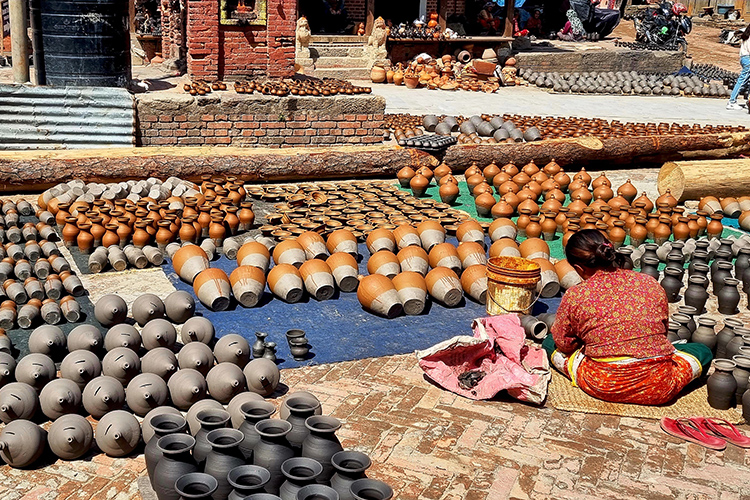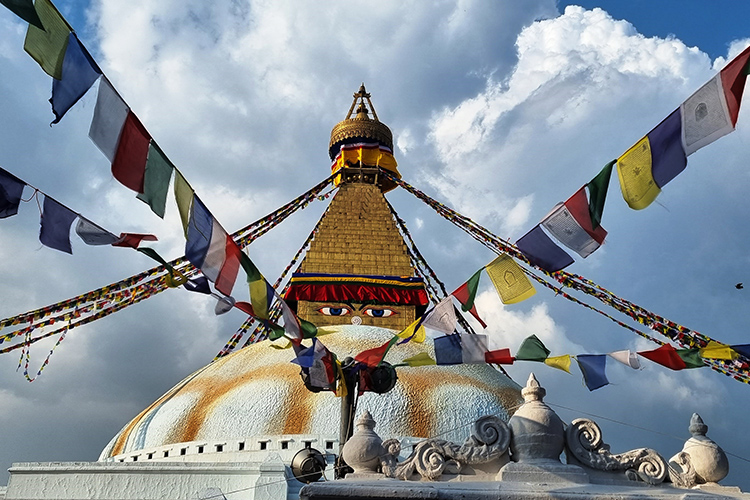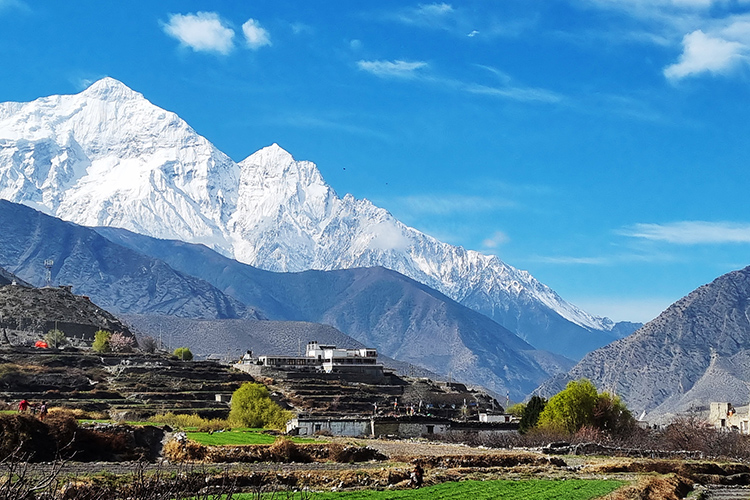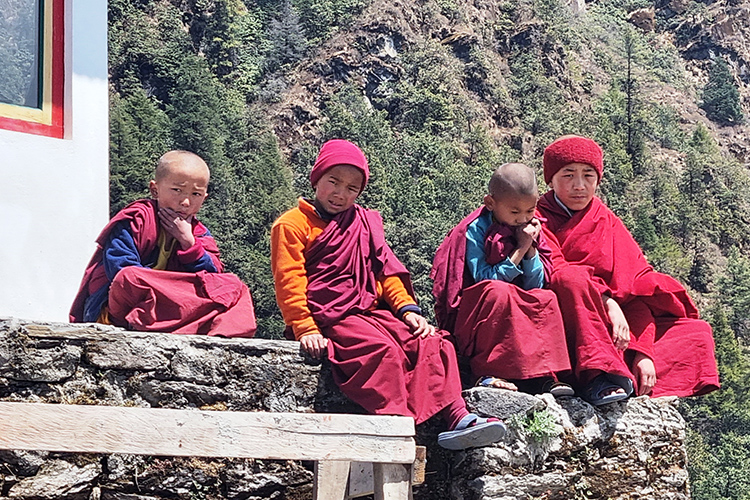Nourishing Nepal
Nepal has to be one of the most compellingly beautiful and diverse mountain countries in the world. Bordered by India to the east, west and south; and by Tibet to the north, it is a long narrow strip of a country stretching east-west. Steamy, fertile, green plains and fabulous wildlife reserves dominate the south and far west. These give way to the gently rolling, foothills of the low Himalaya which gradually rise to the brilliantly white arena of peaks and luscious Alpine meadows of the high Himalayan ranges and some of the highest peaks in the world. It is not only home to Mt. Everest but many other great mountains and massifs - indeed 8 of the 14 ‘eight thousanders’ are in Nepal, a few sharing there space with India or Tibet.
Formerly The Kingdom of Nepal created in 1768, in 2008 it became the Federal Republic of Nepal. Over a period of recent years the country went through both political and geographic / climatic turmoil with the devastating earthquake in 2015 causing untold damage and death. That said, it is quite extraordinary how quickly and beautifully and brilliantly they have rebuilt many of the structures that were affected. With the help of UNESCO and the deep knowledge and skill of generations of carpenters, wood carvers and builders, the restoration work is second to none – quite exemplary and a lesson to the world in how to ‘put things back together’ quickly and efficiently. Looking at many of the restored buildings in Kathmandu, Patan / Lalitpur and Bhaktapur, you would hardly know they were reduced to rubble, had you not known. Today, a visit to Kathmandu is a delight awaiting you – full of history, hugely welcoming people, fabulous architecture, fascinating religious sights, great restaurants, superb hotels, diverse global cuisines and state of the art shops.

Beyond Kathmandu, head south and west to the green jungles of the Terai (aka Tarai), a fertile, lowland belt lying north of the Indo-Gangetic Plain which boasts some of Asia’s game reserves – Chitwan and Bardia National Parks, to name but two. Characterised by sal forest, tall grasslands, swamps and scrubby meadows, it is a haven for a vast species of flora and fauna – including such majestic beasts as tiger and rhinoceros! These wonderful jungles and their inhabitants can be explored from some of the excellent wildlife lodges and camps around the parks.
Head a little north and you begin to reach the low, softly wooded foothills and flower-filled valleys of the foothills of the mighty Himalaya. Pokhara is now a large, bustling city and is considered the gateway to the high ranges and is the start point for many treks and hikes. From here you can do short 3 – 7 day hikes staying in delightful lodges; head off on well-trodden trails and pitch camp where you want; or test yourself with an exhilarating trek up into or around the high peaks. Pokhara also serves as the gateway to the mystical and remote former kingdom of Mustang. Closed until 1992, and today only reached by a sometimes irregular flight or a long, bumpy drive, its long-term isolation has allowed it to preserve its strong customs and culture. On the Tibetan border, its topography is similarly stark, beautiful and arid; its people still speak Tibetic languages and they have similar features. A journey up here is a journey back in time, to a lost and beautiful world –worth the effort and an adventure never to be forgotten. With the advent of a gorgeous new hotel opening, comfort in what was otherwise only a backpacker’s preserve, is now guaranteed.
Head east and you venture towards the mighty Everest / Solukhumbu region, known for its beautiful and little visited sanctuaries; also the start point for treks in this region. Head to Lukla for some wonderful lodge trekking amongst the highest peaks in the world; or head to Phaplu, a delightful small town tucked away in a green, wooded valley, surrounded by ever higher peaks - the land of the Sherpa! Fluttering prayer flags signal Sherpa houses scattered around the valleys and monasteries peer down at you from many a hilltop or craggy mountainside. This region and further east is less visited than other regions and remains wonderfully unspoilt. Sir Edmund Hillary spent many months / years here and kept returning – so much so that he built a hospital in Phaplu and was a much loved figure in the area.

The Sherpa dialect is the main language spoken here along with other dialects that have crept in over the years. Whilst based at your lovely ‘home’ in Phaplu, take time to explore the valleys. The area offers fabulous treks and hikes of almost any length exertion.
Being, as such, a buffer between India and China, Nepal has a long history of migration and immigration and its ethnic groups and castes are as diverse as its terrain. To name but a few, the Chhetri, Bahun, Madeshi, Tawan, Tharu, Newar, Sherpa and Gurung groups all hail from different parts of the country, have different cultures, and date back to different periods of history. They all have their own language and, to the trained eye, their own physicality and features. On your travels through this mystical land you will come across a great many of Nepal’s ethnic groups and it’s a joy to spend time with them, to learn about their traditions, ways of life and their intriguing past.

Nepalese cuisine is a rich and diverse culinary tradition that reflects the country's geographical and cultural diversity. With influences from its neighbouring countries like India, Bhutan and Tibet, Nepalese food offers a unique blend of flavours, spices, and cooking techniques. Dal Bhat, the national dish of Nepal, consists of lentil soup (dal) and steamed rice (bhat) served with a variety of accompaniments like curries, pickles, and yogurt. Momos, dumplings filled with meat or vegetables and steamed or fried, are another popular delicacy that has gained international recognition. Spices such as cumin, coriander, turmeric, and ginger are commonly used in Nepalese cooking, adding depth and aroma to the dishes. Mustard oil is a staple cooking oil, giving a distinctive flavour.
You will also find a wide variety of wonderful vegetarian and vegan options due to religious and cultural influences - curries, lentil soups, and rice-based dishes like pulao and biryani. Additionally, Nepalese food includes traditional snacks like sel roti (sweet rice bread), gundruk (fermented leafy greens), and dhido (a thick porridge-like dish made from buckwheat or cornflour). Generally, Nepalese cuisine is a fabulous fusion of flavours, spices, and textures, offering a culinary experience that is both satisfying and enticing.
Being nestled in the heart of the Himalayas, Nepal boasts a diverse and unique climate which is influenced by its topography and geographical location. The country experiences five distinct seasons: spring, summer, monsoon, autumn, and winter. During spring (March to May), Nepal has mild temperatures with blooming flowers and lush greenery, making it a popular time for trekking and mountaineering. Summer (June to August) brings warmer temperatures, especially in the Terai region, with occasional rainfall and higher humidity. Monsoon season (June to September) is characterized by heavy rainfall, particularly in the southern plains and hilly regions, often leading to landslides and floods. Autumn (September to November) is considered the best time to visit Nepal, with mild temperatures, clear skies, and stunning mountain views. Winter (December to February) brings colder temperatures, especially in higher altitudes, with snowfall in mountainous regions.

It is an ideal time for low-altitude treks and cultural exploration in the lower regions, with crisp, clear days. For adventure seekers and nature enthusiasts there’s somewhere to visit almost throughout the year. Nepal is going through a much deserved and longed for period of peace, solidity, prosperity and development – a kind of long awaited renaissance after its troubled political and climate driven past. Replete with history and a varied culture it is a truly fascinating land. For walkers, trekkers and climbers Nepal really IS ‘the land of plenty’ and you will never run out of magical places to explore on foot. For lovers of the great outdoors, wilderness, mountains, jungles and high altitude deserts, Nepal is the place to go!
